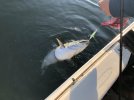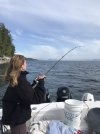acrowe
Active Member
I wondered if anyone is interested in a discussion thread on jigging or drift fishing for salmon?
I know its a real minority but the "High Tech Jigging" thread got a lot of interest in the past and still draws some occasional replies.
I thought there might be a few good topics that could be discussed here:
Gear - Rods, reels, lines but also what lures people like and how they rig them
Boats and electronics - what do we use and what would we choose if we could?
Techniques - from how we actually fish the various jigs used to how position the boat and determine what depths to fish
I'll start
I mostly fish our of Campbell River. Switched over from trolling a couple years ago. I was away from the Island for a long time. When I started fishing here again it seemed to be that the common wisdom is that the 70s and 80s were a sort of glory days when there were more fish and even jigging could catch salmon, now you need to troll if you want to catch fish. I trolled and caught fish, more than I remember catching out of Sooke and Saanich inlet when I was a kid in the late 70s and 80s. I did quite a bit of jigging with my Dad as a kid and in the 80s it was also seen as not a very serious way to catch salmon by many people.
I started trying it again, occasionally with moching rods, monofilament etc, and it did not produce for me. One day trolling off Wilby shoals it totally clicked for me, tons of bait, feeding fish - jigging should work. I read through the High Tech Jigging thread. The next year in may and june I set up to do it more seriously, and it was clear, that jigging would be really productive when you find fish.
Last year I mostly left the downriggers in the garage. I probably caught a similar amount of fish. I generally find it probably worlks out similar to trolling, when you are on the fish it is super productive. Yesterday I found feeding fish immediately and had 6-8 fish on in 10 minutes, released 2, kept one that was bleeding a bunch and went home (which is the unfortunate part about 1 fish limit fishing alone). If the bite is not really on trollers still pick up fish here and there but you have to be pretty lucky to get random fish if they are dispersed jigging.
This year I have had the most success using 4oz Point Wilson Darts in white - I pull off the treble and tie my own assist hooks using gamagatsu 4/0 (or 2/0) and downrigger braid. I honestly think the assist style hooks, hook more fish and get more fish to the boat then single siwash. Sometimes they seem to cause damage when the 2nd hook hooks into something but because they are generally smaller than single siwash hooks that come on stuff they tend not to be quite as damaging that way so I am unsure which is better for releasing fish, which is a big concern these days.
I have tried Shimano butterfly jigs, and I like them. Availability of the size and colours I want when I go to buy them and price affect how much I use them.
I use a variety of rods - this fish which I think was likely around 22lbs I caught last summer on a rig I use in shallower water (under 100") with light lures. Its a baitcasting rod and reel. It seems light but you can actually put a lot of pressure on a fish with it and I felt ok about how quickly I managed this fish (since it had to be released).

I hope there might be an interest in sharing what those of us jigging for salmon are doing
I know its a real minority but the "High Tech Jigging" thread got a lot of interest in the past and still draws some occasional replies.
I thought there might be a few good topics that could be discussed here:
Gear - Rods, reels, lines but also what lures people like and how they rig them
Boats and electronics - what do we use and what would we choose if we could?
Techniques - from how we actually fish the various jigs used to how position the boat and determine what depths to fish
I'll start
I mostly fish our of Campbell River. Switched over from trolling a couple years ago. I was away from the Island for a long time. When I started fishing here again it seemed to be that the common wisdom is that the 70s and 80s were a sort of glory days when there were more fish and even jigging could catch salmon, now you need to troll if you want to catch fish. I trolled and caught fish, more than I remember catching out of Sooke and Saanich inlet when I was a kid in the late 70s and 80s. I did quite a bit of jigging with my Dad as a kid and in the 80s it was also seen as not a very serious way to catch salmon by many people.
I started trying it again, occasionally with moching rods, monofilament etc, and it did not produce for me. One day trolling off Wilby shoals it totally clicked for me, tons of bait, feeding fish - jigging should work. I read through the High Tech Jigging thread. The next year in may and june I set up to do it more seriously, and it was clear, that jigging would be really productive when you find fish.
Last year I mostly left the downriggers in the garage. I probably caught a similar amount of fish. I generally find it probably worlks out similar to trolling, when you are on the fish it is super productive. Yesterday I found feeding fish immediately and had 6-8 fish on in 10 minutes, released 2, kept one that was bleeding a bunch and went home (which is the unfortunate part about 1 fish limit fishing alone). If the bite is not really on trollers still pick up fish here and there but you have to be pretty lucky to get random fish if they are dispersed jigging.
This year I have had the most success using 4oz Point Wilson Darts in white - I pull off the treble and tie my own assist hooks using gamagatsu 4/0 (or 2/0) and downrigger braid. I honestly think the assist style hooks, hook more fish and get more fish to the boat then single siwash. Sometimes they seem to cause damage when the 2nd hook hooks into something but because they are generally smaller than single siwash hooks that come on stuff they tend not to be quite as damaging that way so I am unsure which is better for releasing fish, which is a big concern these days.
I have tried Shimano butterfly jigs, and I like them. Availability of the size and colours I want when I go to buy them and price affect how much I use them.
I use a variety of rods - this fish which I think was likely around 22lbs I caught last summer on a rig I use in shallower water (under 100") with light lures. Its a baitcasting rod and reel. It seems light but you can actually put a lot of pressure on a fish with it and I felt ok about how quickly I managed this fish (since it had to be released).

I hope there might be an interest in sharing what those of us jigging for salmon are doing


